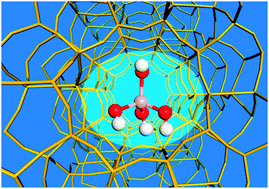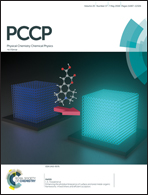Identifying the effective phosphorous species over modified P-ZSM-5 zeolite: a theoretical study
Abstract
In this work, a density functional theory (DFT) study was carried out to address the fundamental description of the effective phosphorous species that could improve the framework stability and reduce the coke deposition formation on the P-ZSM-5 zeolite. On the basis of the dealumination barriers of ZSM-5 with all the possible phosphorous species bound on the zeolite framework, PO4H4 was ascertained to be the effective phosphorous species that could improve the ZSM-5 zeolite hydrothermal stability and reduce its acid strength. Apart from this, the olefin polymerization reaction is the main cause of coking deactivation for ZSM-5. Thus, the effect of the modification P-ZSM-5 on the reactivity of light olefins dimerization was also studied. Compared to the unmodified ZSM-5, the activation energy of the rate-limiting step of ethylene dimerization was increased from 20.3 kcal mol−1 to 34.6 kcal mol−1, thereby apparently inhibiting ethylene dimerization and improving the resistance to coke deposition for P-ZSM-5. Our calculation results should provide a beneficial theoretical guide for designing and improving a catalyst for the methanol-to-olefins process and bioethanol dehydration.

- This article is part of the themed collection: 2018 PCCP HOT Articles


 Please wait while we load your content...
Please wait while we load your content...